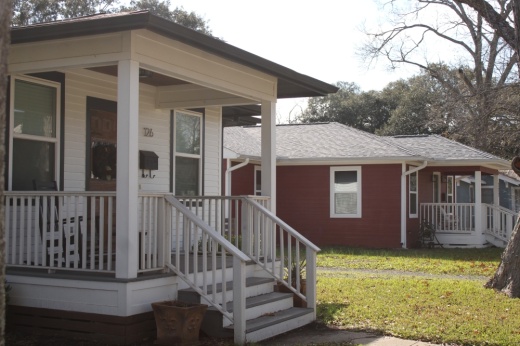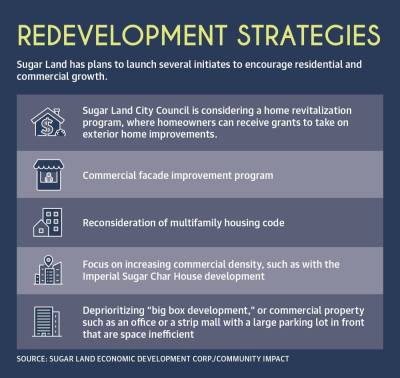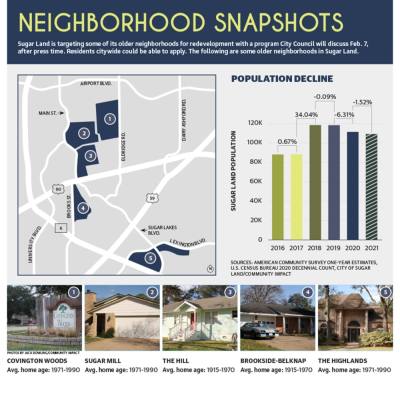Editor's note: This story has been updated from its original printed version to account for Sugar Land City Council approving the Great Homes program Feb. 7, after press time. With just 4% of the city’s incorporated acreage undeveloped, the city of Sugar Land finds itself at a crossroads.
The city’s lack of available land for development means the city must plan and execute a barrage of redevelopment strategies if it wants to remain competitive with area cities, Sugar Land Communications Director Doug Adolph said. U.S. Census Bureau data also shows a decline in population for the city of Sugar Land.
“To stay relevant with a competitive edge, while also preserving the quality of life for current and future residents, we’ve got some choices to make,” he said. “We are no longer experiencing high growth, so it’s important for the city to start taking a look at areas that could benefit from redevelopment and/or reinvestment.”
To that end, Sugar Land approved a home improvement grant program dubbed the
“Great Homes program" on Feb. 7. The program will provide an incentive for owners of older homes to undergo exterior renovations.
The Great Homes Program is just the tip of the iceberg, however.
“More people and housing are a key component in supporting new commercial development and amenities,” Adolph said. “The most important thing is to continue to grow and attract new residents by providing options for downsizing and pathways to home ownership for the younger generations.”
A history of growthAdam Perdue, a research economist at the Texas Real Estate Research Center, explained the context of Sugar Land’s growth.
“Galveston used to be the prime job market,” he said. “But after the [Galveston Hurricane of 1900], everyone started heading north to Houston. As Houston proper continued to grow, population and employment spread out from central Houston.”
Perdue said the building of Hwy. 59, I-10 and the Westpark Tollway made Fort Bend County the prime destination for “green field development,” which is when companies buy land on the outskirts of cities to develop.
Adolph said Sugar Land is mostly developed now. The only place left to grow, then, is inward and upward.
Data from the city’s website, which Adolph said is from the American Community Survey, shows Sugar Land’s population dropped from 118,498 in 2021 to 111,026 in 2022. Sugar Land also faces rising property values and an aging home base, as its average home was built in 1992.
“What we get is a coincidence where some of the houses are old, and you just can’t maintain them,” Perdue said. “Land values are expected to increase. It starts to make sense to tear down the old houses and build more densely.”
Redefining growth Perdue said he believes the next step for Sugar Land is to invest in multipurpose districts as well as multifamily housing. But there is a catch: While multifamily housing is not banned in Sugar Land, it is discouraged.
“Current [development] codes do not encourage multitenant housing,” said Devon Rodriguez, deputy director of the Sugar Land Economic Development Corp. “But we are exploring ways to diversify our housing stock.”
The city’s land use plan, a comprehensive 20- to 25-year plan approved in August 2018, set a target of 88% single-family and just 12% multifamily residential development. The plan prohibits the build-out of residential-only apartment complexes, instead requiring those developments to be integrated into vertical mixed-use developments or as part of a larger activity center such as
Sugar Land Town Square or
Lake Pointe Town Center.
Rodriguez said the city must follow the path to the highest taxable value for its land and preserve a strong quality of life for its residents.
“We have to look at intensifying current development,” she said. “This is the housing stock that has to meet the needs of existing residents and attract new residents.”
It falls to the city then, to pursue redevelopment strategies that can improve the quality of life for new and existing residents.
‘A two-pronged approach’
The city can attract high-value businesses if it can show them that residents are interested in moving to and staying in the area, Rodriguez said.
“We have a two-pronged approach of targeting both the commercial and residential aspects of living and working in Sugar Land,” Rodriguez said. “It all comes together to financially sustain the community in the long term.”
As such, the city is considering four key areas of redevelopment. The first is the preservation of the Imperial Historic District, which includes the Imperial Sugar Char House.
PUMA Development announced in December it had an agreement with the city to develop the Char House and surrounding land. Plans for the multi-use development include offices, eateries, parks and multifamily housing.
However, at a
Jan. 24 meeting about the project, residents spoke out against high-density housing as part of the Char House.
“I don’t know if we necessarily need to put up apartments to support what’s going on at the Char House,” resident Mark McDonald said.
Additionally, Lake Pointe Town Center, a shopping and park area located along Brooks Lake across from Hwy. 6 and Hwy. 59, is a growth opportunity for the city. Rodriguez said engineering and construction company Fluor owns about 1 million square feet of the development, and surrounding areas are mostly filled in with commercial development and parking.
“We’d like to explore what can be done with the surrounding area to make it more efficient,” she said.
In general, Sugar Land discourages “big box development,” as it reduces a development’s walkability as well as commercial density, according to the city’s land use plan. To that end, the city is looking to re-evaluate how land is used at Lake Pointe Town Center.
Sugar Land City Council approved the
Great Homes program, which could inject new life into older neighborhoods, at the Feb. 7 meeting with a 6-1 vote. The program is split into two components: the Great Homes Design program and the Great Homes Update program. The city has set aside $620,000 across the two programs to pilot these programs.
Rodriguez said another program could provide a financial incentive for exterior commercial facade improvements.
With these programs in mind, Sugar Land officials said they hope to remain competitive in business and housing development in the future.
Correction: In the print version and attached graphic from the edition, data was provided regarding the number of homes and population for given communities across Sugar Land. On further review, this data does not meet our criteria for trustworthiness. The attached graphic has been updated.







